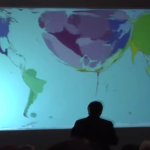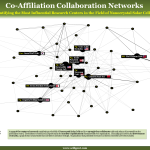Science Magazine September 13, 2019 When PLOS ONE debuted in 2006, it became the world’s largest journal, publishing more than 30,000 papers at its height in 2013 and spawning more than a dozen imitators. From 2013 to 2018, PLOS ONE’s output fell by 44%. Growth in new megajournals has not offset the declines. In 2018, PLOS ONE, Scientific Reports, and 11 smaller megajournals collectively published about 3% of the global papers total. Driving the fall in output is a decline in submissions, they have lost have their appeal of rapid publication and as publishing volumes have declined, so have megajournals’ […]
Category Archives: Bibliometrics
With little training, machine-learning algorithms can uncover hidden scientific knowledge
Science Daily July 3, 2019 A team of researchers in the US (Lawrence Berkeley National Laboratory, UC Berkeley) fed 3.3 million abstracts from papers on materials science published in more than 1,000 journals between 1922 and 2018 into an algorithm called Word2vec. The algorithm took each of the approximately 500,000 distinct words in those abstracts and turned each into a 200-dimensional vector, or an array of 200 numbers, and predicted discoveries of new thermoelectric materials years in advance and suggested as-yet unknown materials as candidates for thermoelectric materials. The research suggests that latent knowledge regarding future discoveries is to a […]
TechSight Snapshot Reports
While we are no longer providing contractor support to the Office of Net Technical Assessments (ONTA) of ASD(R&E) (now USDR&E), we are proud of the work we performed and are pleased to share some of the products that have been cleared for publicly release. Over the course of several months in 2017, we helped ONTA develop several bibliometric reports on key emerging technologies using their TechSight system. These TechSight Snapshot Reports were cleared for public release and sent to S&T News Bulletin readers and TechSight users on a monthly cycle. After receiving multiple inquiries about where these can be found, we decided to […]
Scientists teach the neural network to carry out video facial recognition — using a single photo
Eurekalert July 5, 2018 Researchers in Russia used the theory of fuzzy sets and probability theory to develop a video recognition algorithm. The algorithm significantly improves the accuracy (by 2-6% compared to earlier experiments) of identifying faces by video in real time with a small number of images for several well-known neural network architectures, such as VGGFace, VGGFace2, ResFace and LightCNN. It estimates to what degree one frame is closer to one person, and to what degree the other frame is closer to the next person. Then it compares how similar the training still photos of these two people are […]
Topic-adjusted visibility metric for scientific articles
Phys.org May 10, 2018 As different academic disciplines have different research behaviours and citation practices, a comparison of research quality across different disciplines based on raw citation counts would not reflect accurately the research merit. An international team of researchers (USA – Columbia University, Singapore) has developed an article-level metric, called “topic-adjusted visibility metric”, which is able to automatically account for the variation in citation activities among different research fields by using a complex network containing attributes belonging to the selected article. Each article need not belong to a single field but can belong to multiple fields with varying degrees. […]
What sort of stream networks do scientific ideas flow along?
Physorg January 12, 2018 Researchers in Poland have shown that tracking the dependencies between co-authors reveals not only the paths along which scientific ideas flow, but also reconstructs the structure of scientific cooperation and detects emerging communities. Interestingly, the proposed method of analysis can be an effective tool to fight terrorists and even dishonest politicians… read more. TECHNICAL ARTICLE
Neil Tyson touches on Scientometrics
During a talk on science policy, Astrophysicist Neil deGrasse Tyson shows some scientometric charts with interesting visualizations. Specifically he shows the volume of scientific articles as a function of country of publication, as well as the rate of publication growth. On a map of the Earth, the geographical size of each country is increased or decreased in proportion to this amount. Here is the total publications map: The USA, Europe and Japan dominate. Here is the rate of growth map: Europe and Japan are both growing strong, while China is rapidly on the rise, and the USA definitely growing much […]
Co-Affiliation Collaboration Networks
Last month, we participated in a symposium on Technology Forecasting at the Library of Congress. Here is the poster we displayed at our vendor booth showing our approach to Co-Affiliation Collaborative Mapping. Download the poster to get a better view: Co-Affiliation Collaboration Map (Poster)
Introducing Scimetry Reports…
We’ve completed the development of our prototype! We’re now rolling this into a service before we develop it into a product. The Scimetry Report is a new type of report for the science professional that is generated using semi-automated, quantitative methods for visualizing knowledge and measuring global progress in the research and development of scientific fields. All reports include the following scientific metrics: A collaboration map of institutional powerhouses A ranking of high performance talent An analysis of major research fronts A trend analysis of specific research progress Background The activity of the science, technology and innovation community […]
Our founder’s work on scientific networks published
Our article on “Statistical Common Author Networks” was published recently in the Journal of the American Society for Information Science and Technology. The article is available on the JASIST website to download or purchase here. Below is the abstract to give you an idea about what the article is about: ABSTRACT: A new method for visualizing the relatedness of scientific areas has been developed that is based on measuring the overlap of researchers between areas. It is found that closely related areas have a high propensity to share a larger number of common authors. A method for comparing areas of […]

